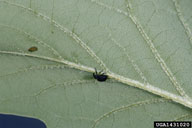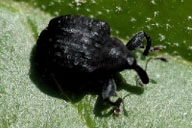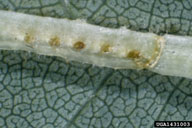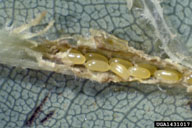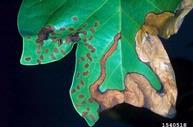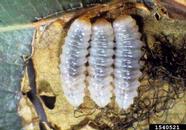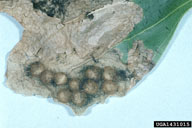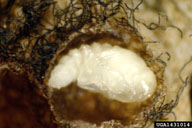Yellow-poplar weevil
Odontopus calceatus (Say) (Coleoptera: Curculionidae)
Orientation to pest
Yellow-poplar weevil, Odontopus calceatus (Say), feeds on yellow-poplar (Liriodendron tulipifera L.), magnolia (Magnolia), and sassafrass (Sassafras albidum [Nuttall] Nees.). The weevil overwinters as an adult and upon emergence, adults feed on buds or developing leaves. Eggs are laid in leaf veins and larvae feed as leafminers. Multiple larvae may coexist in a single common mined area. Outbreaks in yellow-poplar have occurred since 1960 in eastern Kentucky, Tennessee, Ohio, West Virginia, and Virginia.
Hosts commonly attacked
This weevil feeds on yellow-poplar (L. tulipifera), magnolia (Magnolia), and sassafrass (S. albidum).
Distribution
This weevil is found throughout the eastern United States within the range of its hosts.
Images of yellow-poplar weevil
| Figure 1. Adults of yellow-poplar weevil, Odontopus calceatus, on leaf (top) and close up (bottom) | Figure 2. Oviposition wounds (top) and eggs of yellow-poplar weevil (revealed by dissection) (bottom) in leaf vein | Figure 3. Larval mine (top) and larvae (bottom) (seen by opening mine) of yellow-poplar weevil | Figure 4. Cocoons in leaf (top) and pupa (bottom) (revealed by opening cocoon) of yellow-poplar weevil |
Important biological control agents related to this pest species
Unspecified species of parasitoids have been noted to destroy up to 50% of larvae in mines.
Web links for information on yellow-poplar weevil
- Fact Sheet | UK Entomology, University of Kentucky
- Guide on Species Recognition and Habits | L.L. Hyche, Auburn University
Citations and links to over 20 photos and figures are interspersed throughout the text - Forest Insect & Disease Leaflet 125 | USDA Forest Service
Articles
- Burns, D. P. and L. P. Gibson. 1968. The leaf mining of yellow-poplar. The Canadian Entomologist 100: 421-429.
- Hyche, L. L. 1994. The yellow-poplar leaf-mining weevil. A guide to recognition and habits in Alabama. Bulletin No. 622 of the Alabama Agricultural Experiment Station, Alabama Agricultural Experiment Station, Auburn University, 13 pp.
